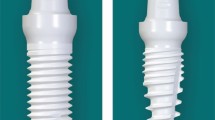Abstract
Data sources
Medline, The Cochrane Library, bibliographies of identified studies and hand searching of the journals, Schweizer Monatsschrift fur Zahnmedizin (Acta Medicinae Dentium Helvetica) and Deutsche Zahnärztliche Zeitschrift and Implantologie.
Study selection
Randomised-controlled clinical trials, prospective and retrospective studies providing information on ceramic and metal abutments with a mean follow-up time of at least 3 years were included. Patients had to have been examined clinically at the follow-up visit.
Data extraction and synthesis
Assessment of the identified studies and data abstraction were performed independently by three reviewers. Failure rates were analysed using standard and random-effects Poisson regression models to obtain summary estimates of 5-year survival proportions.
Results
A total of 29 studies providing information on the clinical performance of the implant abutments were included in the analysis. The estimated 5-year survival rate of ceramic abutments was 99.1% [95% confidence interval (CI): 93.8-99.9%] and 97.4% (95% CI: 96-98.3%) for metal abutments. The estimated cumulative incidence of technical complications after 5 years was 6.9% (95% CI: 3.5-13.4%) for ceramic abutments and 15.9% (95% CI: 11.6-21.5%) for metal abutments. Abutment screw loosening was the most frequent technical problem, occurring at an estimated cumulative incidence after 5 years of 5.1% (95% CI: 3.3-7.7%). All-ceramic crowns supported by ceramic abutments exhibited similar annual fracture rates as metal-ceramic crowns supported by metal abutments. The cumulative incidence of biological complications after 5 years was estimated at 5.2% (95% CI: 0.4-52%) for ceramic and 7.7% (95% CI: 4.7-12.5%) for metal abutments. Aesthetic complications tended to be more frequent at metal abutments.
Conclusions
The 5-year survival rates estimated from annual failure rates appeared to be similar for ceramic and metal abutments. The information included in this review did not provide evidence of differences for the technical and biological outcomes of ceramic and metal abutments. However, the information for ceramic abutments was limited in the number of studies and abutments analysed as well as the accrued follow-up time. Standardised methods for the analysis of abutment strength are needed.
Similar content being viewed by others
Commentary
Dental implants are widely used by specialists and general practitioners, and many new products are on the market. As such, demand for products that have longevity and are aesthetically acceptable is an important objective for the practitioner in selecting products to use. Since ceramic implant abutments made their appearance in the 1990s, many studies have attempted to compare the reliability of ceramics to metal.
The present review attempted to answer an important question with regards to the clinician's decision to use ceramic abutments or metal abutments for single or multiple implant restorations. It also evaluates the long term success and possible complications, considering patients’ demands for aesthetics along with the increasing amount of new materials available.
Ceramic materials are being recommended for their biocompatibility and better aesthetics compared to metal, not only as abutments for implants but also for crowns, inlays, onlays, fixed partial dentures for anterior and posterior teeth and even as implants replacing titanium implants. All-ceramic products are now in the market and being tested constantly. However all-ceramic restorations are known for their tendency to fracture.
Since all-ceramic restorations are fairly new materials not many long term studies can be found in the literature. The search of only two electronic databases along with published articles and manuscripts in English and German could miss some important information.
Observational studies, like the majority of prospective and retrospective studies included in the review, are a good source of information and can analyse many variables as reported in the results within the review, but for therapy comparisons cohort studies can have risk of bias and confounding: many of the studies did not have a control group or had a high dropout rate. Additionally the systematic review lacked a quality assessment of the individual studies.
The review found no statistically significant difference between the two therapies, however the result may be due to the limited amount of clinical trials comparing the two treatment modalities and that more clinical trials were performed in search of the long term outcomes of the traditional implants with metal abutments. The mean follow up for the ceramic abutments was 3.7 years and that of metal abutments 4.8 years. These two factors, low number and short time period follow up, indicate that ceramic abutments for implants is in its infancy.
Altogether, the studies reported on only 166 ceramic abutments vs. 5683 metal abutments. A few findings added surprise. Seventeen all-ceramic crowns supported by metal abutments were lost due to fracture, while no all-ceramic crowns supported by a ceramic abutment fractured. No reason was advanced. The other surprise was a higher incidence of soft tissue recession at ceramic abutments. One reason postulated by the authors is that ceramic abutments are used more frequently in the anterior maxilla where the risk of recession might be higher than in the molar region with its thicker soft tissue. The one outcome of no surprise was that aesthetic problems occurred with 0% of the ceramic abutments and 6.6% of metal abutments. Again, this difference was not statistically significant.
Recent studies showed that out of all the commercially available ceramic materials Zirconia offers good results due to its mechanical properties.1 Some studies are indicating the effectiveness of all ceramic restorations2 and its use as implant abutment as suggested by the Nobel Biocare Company. A recent systematic review found that Zirconia abutments presented values of fracture strength which were not as good as conventional titanium abutments, however their use can be indicated in aesthetically compromised areas.1
The review demonstrates promising results for all ceramic restorations: however the clinicians expertise and the patient's needs should be combined when applying the present evidence.
Practice points
-
All ceramic abutments for implants seem to be a good option for long term implant restoration in the aesthetic zone but due to the limited number of clinical studies found, the results should be interpreted with caution.
References
Gomes A L, Montero J . Zirconia implant abutments. A review. Med Oral Patol Oral Cir Bucal 2010; [Epub ahead of print].
Della Bona A, Kelly R . The clinical success of all-ceramic restorations. J Am Dent Assoc 2008; 139 (suppl.): 8S–13S.
Author information
Authors and Affiliations
Additional information
Address for correspondence; Dr med. dent. Irena Sailer, Clinic for Fixed and Removable Prosthodontics and Material Science, Center for Dental and Oral Medicine, University of Zurich, Plattenstr. 11, CH 8032 Zurich, Switzerland. E-mail: irena.sailer@zzmk.uzh.ch
Sailer I, Philipp A, Zembic A, Pjetursson BE, Hämmerle CH, Zwahlen M. A systematic review of the performance of ceramic and metal implant abutments supporting fixed implant reconstructions. Clin Oral Implants Res. 2009; 20 (suppl. 4): 4–31.
Rights and permissions
About this article
Cite this article
Keenan, A., Levenson, D. Are ceramic and metal implant abutments performance similar?. Evid Based Dent 11, 68–69 (2010). https://doi.org/10.1038/sj.ebd.6400731
Published:
Issue Date:
DOI: https://doi.org/10.1038/sj.ebd.6400731
This article is cited by
-
Influence of abutment material on the stress of implant-supported all-ceramic single crown
Journal of Wuhan University of Technology-Mater. Sci. Ed. (2012)



